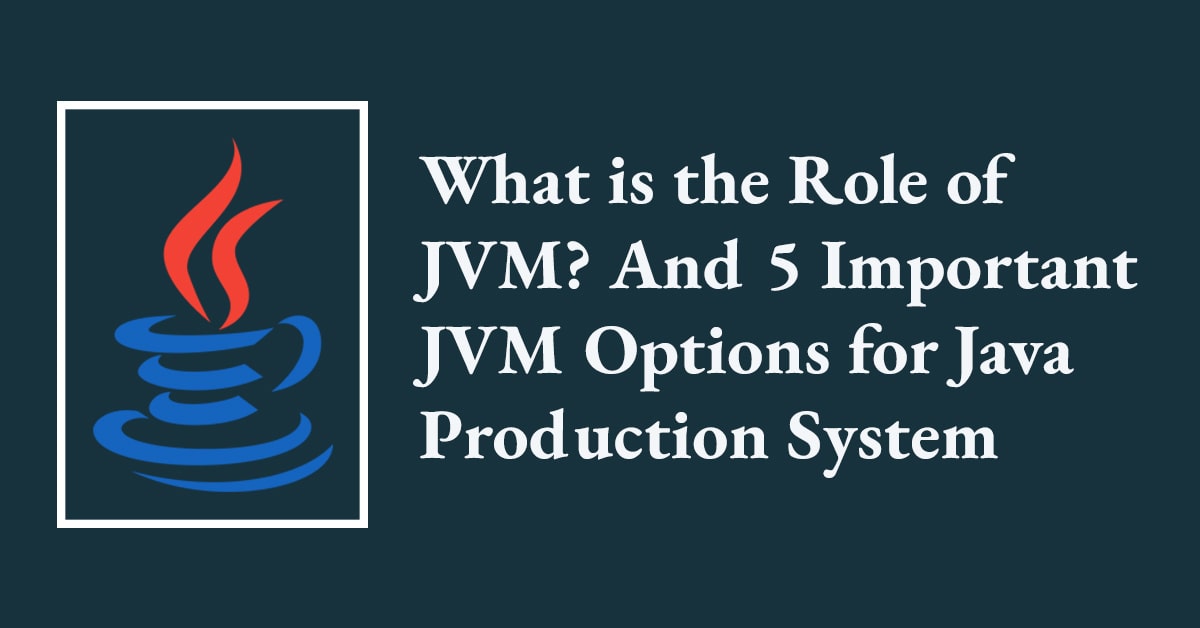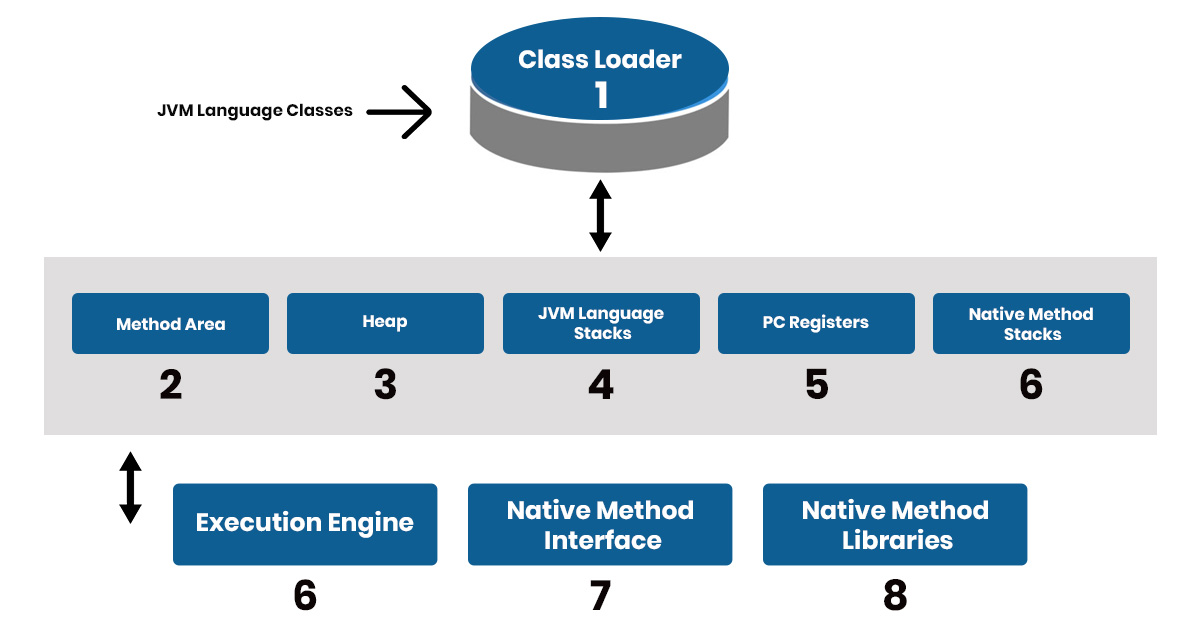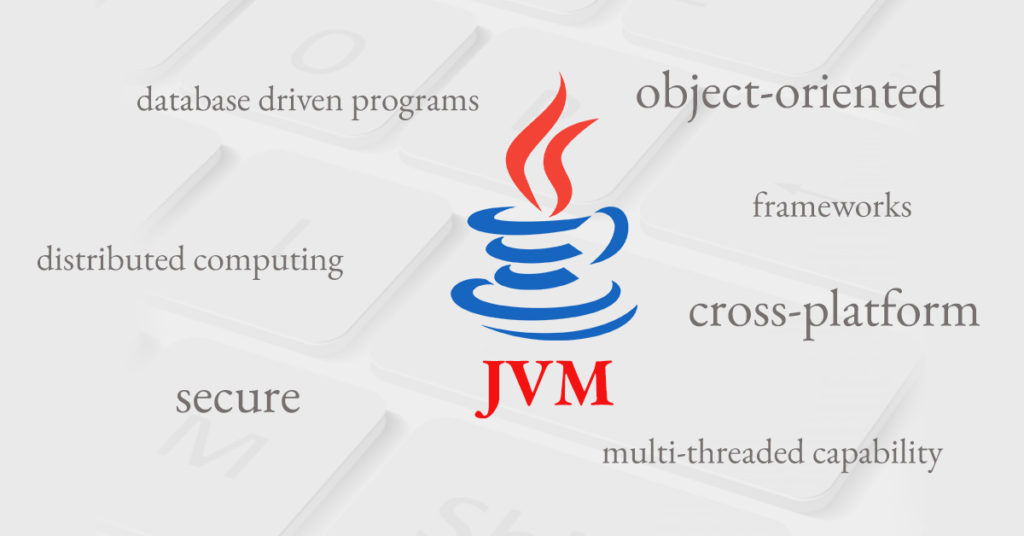What is the Role of JVM? And 5 Important JVM Options for Java Production System

4 min read | By Admin | 25 September 2020 | Frameworks
JVM represents a java virtual machine which is a virtual computing machine or abstract computing machine is the execution of a JVM specification. It explains the bundled Java code called byte code and assists to execute the program depending on the specific stage. Java virtual machine is a platform independent execution milieu which alters machine language into Java byte code and is proficient in implementing byte code. It’s a portion of the Java runtime environment that is required by each operating framework.JVM introduced two revolutionary concepts that became the standard for modern software development, “write once, run anywhere” and automated memory management.The Java Virtual Machine was originally intended only for Java, and today it has been developed to support many programming languages, including Kotlin, Scala, and Groovy.The role of JVM administers system memory and affords a minimal functional environment for Java based applications and still persists to patronage programming innovations today.Let’s know here what is the role and responsibility of JVM in program execution to build an eminent software development.
What is the Role of JVM in Java?
Java is compiled into Java bytecode, which is then translated into a specialized platform by an interpreted Java Interpreter. Actually, this Java interpreter is called Java Virtual Machine. The role of JVM in Java is an abstract machine designed to be implemented on top of existing processors. The purpose of JVM is to provide a runtime environment that enables Java applications to run on any device or operating system without modification. It hides the underlying operating system from Java applications. See below for a comprehensive understanding of JVM’s role in Java.
The role of JVM in Java is an abstract machine designed to be implemented on top of existing processors. It hides the underlying operating system from Java applications.
See below for comprehensive understanding of JVM role in Java.
What is JVM?
JVM implies in terms of Java Virtual Machine. It is a specification that bestows a runtime environment in which Java bytecode can be executed and is an abstract machine. Functionality of JVM includes managing memory, executing bytecode, and ensuring platform independence for Java applications. JVM can be implemented in many hardware and software platforms. Also, it has run on both client and server-side platforms. JVM includes a Just-in-Time compiler that converts bytecode into a machine language so that it runs as fast as the native executable. In many programming languages, the compiler generates machine code for a particular system. However, the Java compiler generates the code for a virtual machine, called a JVM.

JVM can be implemented in many hardware and software platforms. Also, it has run on both clients and server-side platforms. JVM includes a Just-in-Time compiler that converts bytecode into a machine language so that it runs as fast as the native executable.
In many programming languages, the compiler generates machine code for a particular system. However, the Java compiler generates the code for a virtual machine, called a JVM.
For What JVM is Utilized
 𝐓𝐡𝐞 𝐫𝐨𝐥𝐞 𝐨𝐟 𝐉𝐕𝐌 𝐡𝐚𝐬 𝐭𝐰𝐨 𝐦𝐨𝐦𝐞𝐧𝐭𝐨𝐮𝐬 𝐜𝐚𝐩𝐚𝐜𝐢𝐭𝐢𝐞𝐬:
𝐓𝐡𝐞 𝐫𝐨𝐥𝐞 𝐨𝐟 𝐉𝐕𝐌 𝐡𝐚𝐬 𝐭𝐰𝐨 𝐦𝐨𝐦𝐞𝐧𝐭𝐨𝐮𝐬 𝐜𝐚𝐩𝐚𝐜𝐢𝐭𝐢𝐞𝐬:
- To permit Java programs to run on operating systems and any device.
- To manage and enhance program memory.
- Verifies code
- Executes code
- Provides runtime environment
- Loads code
- JVM specification
- JVM implementations
- JVM instance
JVM Architecture

Benefits of Java Virtual Machine

𝐂𝐫𝐨𝐬𝐬 𝐏𝐥𝐚𝐭𝐟𝐨𝐫𝐦
- A program that is Cross platform has the ability to run effectively on various kinds of hardware.
- Java is likewise a cross-platform language (for instance) it is viable to run a solitary bit of code composed of specific hardware, on whatever other hardware that has JVM installed on it.
- A program isn’t constantly required for a Java program to execute, there are numerous Java applications accessible too for the equivalent. They run on the desktop similarly as the customary programs do.
- At the point when Java was first evolved, security had precedence. That is the fundamental cause, why java programs run separated in an encased zone of the java virtual machine which perform as a securing shield.
- The role of Java Virtual Machine guards the operating system by keeping any malignant programming from assaulting it. This guarantees its security by not permitting java applications to cooperate with operating system resources.
- The role of JVM in Java permits developers to compose Java programs that are profoundly secure with assistance of its underlying security highlights. The use of JVM in Java enables seamless execution across multiple platforms, ensuring compatibility and reliability.
- The role of JVM in Java permits developers to compose Java programs that are profoundly secure with assistance of its underlying security highlights.
- The JVM accompanies a JIT compiler which changes over the Java code into a low level machine language that can run as quick as the customary applications.
- This aggregated code goes into the stored memory of the program, this implies one can utilize the code again without downloading it over and over gathering it.
What are JVM components?
The Java Virtual Machine (JVM) is made up of several key components that enable the execution of Java programs:
𝐂𝐥𝐚𝐬𝐬 𝐋𝐨𝐚𝐝𝐞𝐫: Loads and links Java classes dynamically at runtime
𝐌𝐞𝐦𝐨𝐫𝐲 𝐀𝐫𝐞𝐚𝐬: Divided into different sections for efficient memory management:
●Method Area: Stores class metadata and static variables
●Heap: Allocates memory for objects
●Stack:Handles method execution and local variables
●PC Register: Keeps track of the current instruction
●Native Method Stack: Supports native method execution
𝐄𝐱𝐞𝐜𝐮𝐭𝐢𝐨𝐧 𝐄𝐧𝐠𝐢𝐧𝐞: Converts bytecode into machine code and executes it using:
●Interpreter:Processes bytecode one instruction at a time
●JIT Compiler:Optimizes performance by converting bytecode to native code
𝐆𝐚𝐫𝐛𝐚𝐠𝐞 𝐂𝐨𝐥𝐥𝐞𝐜𝐭𝐨𝐫: Frees memory by removing unused objects
𝐍𝐚𝐭𝐢𝐯𝐞 𝐈𝐧𝐭𝐞𝐫𝐟𝐚𝐜𝐞:Connects Java applications with native system libraries
These components work together to ensure Java programs run efficiently across different platforms.
JVM Options for Java Production System
JVM options have three sorts of options that you can incorporate to your JVM, standard, non-standard, and advanced options. Whether you attempt an advanced option, you generally utilize the option with (-XX). Suchlike, in case you’re applying a non-standard option, you utilize (-X). Standard options do not prepare anything for choice. Below are the list of JVM Options for Java Production. ⒈ 𝐄𝐧𝐚𝐛𝐥𝐞 𝐂𝐥𝐚𝐬𝐬 𝐃𝐚𝐭𝐚 𝐒𝐡𝐚𝐫𝐢𝐧𝐠 (𝐂𝐃𝐒)- Indicate (Xshareclasses) option to empower class data apportion in a shared class cache.
- The Java Virtual Machine learning interfaces with a current cache or else makes a cache if that one doesn’t exist.
- The Java Virtual Machine learning interfaces with a current cache or else makes a cache if that one doesn’t exist. Importance of JVM in Java ensures efficient execution and resource management.
- You can have different caches, and you can indicate the right cache by adding a sub alternative to the (Xshareclasses) option.
- JAVA Classpath (-Xbootclasspath) determines classpath inputs we need loaded without confirmation.
- The JVM checks all classes it burdens to guarantee that it doesn’t attempt to dereference an object with an int, additional passages off the stack or push too much.
- Placing the class on the bootclasspath also avoids the expense, however ought to possibly be utilized when you realize that the classes have been checked commonly previously.
- In JRuby, this diminished startup time considerably and more for basic script.
- -Xms – Initial Java heap size: This option is to characterize the beginning heap size for JVM, (Xms2048m) which is 2 GB for the initial pile size of the JVM.
- -Xmx – maximum Java heap size: This option is to characterize the greatest heap size of JVM, (Xmx2048m) which means the most extreme heap size of JVM will be 2 GB.
- -Xss – It’s a java thread stack size.
- -XX:MinHeapFreeRatio – The minimum percentage of heap free after GC to evade extension; to maintain the heap utilization, you can utilize JConsole.
- -XX:MaxHeapFreeRatio – The most extreme level of heap free after GC to avert dwindle.
- It is the way toward observing different JVM levels parameters, for example, garbage collections, thread executions, method executions, and object creations.
- Java Profiling furnishes you with a better perspective on your objective application execution and its resource utilization.
To Conclude
Hope this article will help you in an excellent way and you can use the above JVM options for java production. If you need any assistance, just approach us today, we”ll make your business be lofty. div class=”fwdthinking” style=”padding-bottom: 60px;”>Most Frequently Asked Questions About Jvm
JVM, Java Virtual Machine, is a software engine that runs Java programs by converting bytecode into machine code. Significance of JVM lies in its ability to provide platform independence, manage memory efficiently, and optimize execution for better performance.
JVM (Java Virtual Machine) is a software engine that runs Java programs by converting bytecode into machine code. It enables platform independence and manages memory, making Java applications efficient and secure.
Java Virtual Machine (JVM) is an essential part of the Java Runtime Environment. It functions as Java applications as a run-time engine, loading, verifying, and executing Java bytecode, allowing Java applications to run on different operating systems without modification.
JVM performs several key functions, including:
- Loading and executing Java programs by interpreting or compiling bytecode.
- Managing memory through automatic garbage collection.
- Ensuring security by verifying bytecode before execution.
- Providing platform independence, allowing Java programs to run anywhere.
The latest from our editors
Join over 150,000+ subscribers who get our best digital insights, strategies and tips delivered straight to their inbox.




 (11 votes, average: 4.82 out of 5)
(11 votes, average: 4.82 out of 5)
Comments are closed.